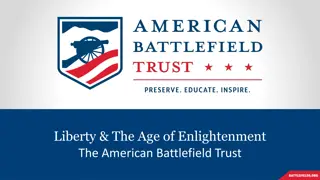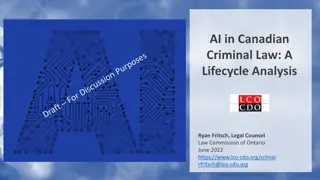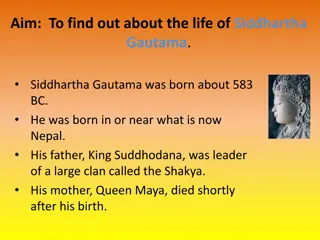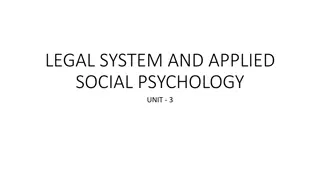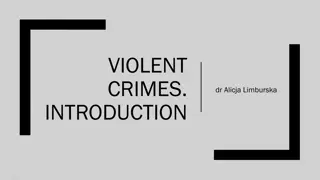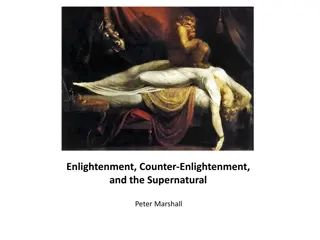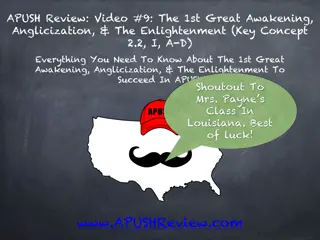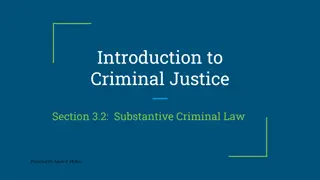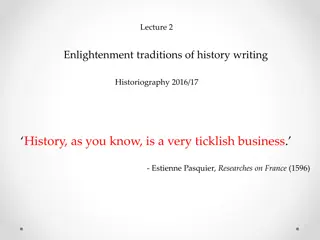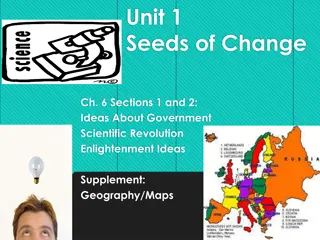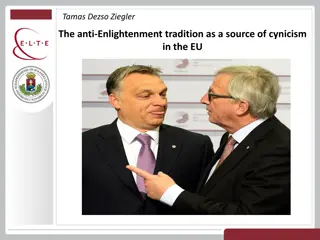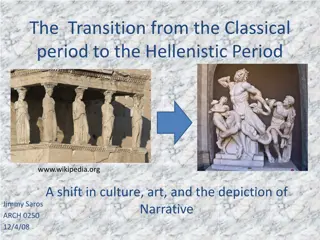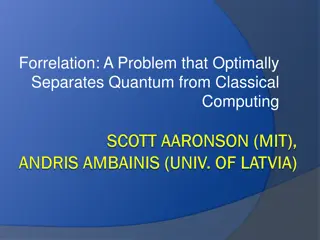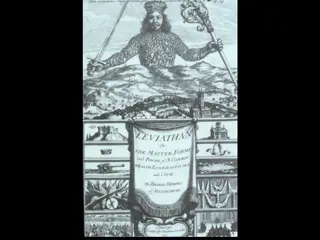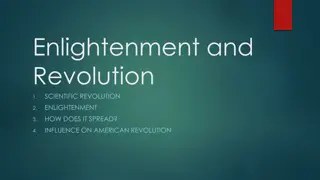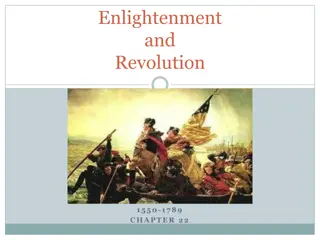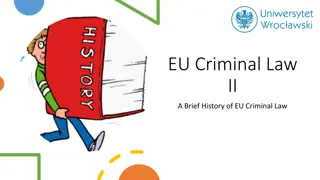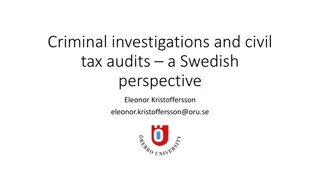Evolution of Criminal Law and Thought: From Pre-Classical Era to Enlightenment
Explore the progression of criminal law and thought from the Pre-Classical School of Thought to the Enlightenment era. Delve into concepts like folkways, mores, and the origins of criminal law, including examples such as societal norms, dress codes, and supernatural explanations for behaviors during the demonic era. Discover the development of criminal codes like Hammurabi's and the impact of common law. Gain insights into how societal norms and laws have evolved over time to shape our understanding of crime and justice.
Download Presentation

Please find below an Image/Link to download the presentation.
The content on the website is provided AS IS for your information and personal use only. It may not be sold, licensed, or shared on other websites without obtaining consent from the author.If you encounter any issues during the download, it is possible that the publisher has removed the file from their server.
You are allowed to download the files provided on this website for personal or commercial use, subject to the condition that they are used lawfully. All files are the property of their respective owners.
The content on the website is provided AS IS for your information and personal use only. It may not be sold, licensed, or shared on other websites without obtaining consent from the author.
E N D
Presentation Transcript
PRE-CLASSICAL SCHOOL OF THOUGHT MORES, FOLKWAY, DEMONIC ERA, ORIGINS OF CRIMINAL LAW, THE ENLIGHTENMENT
PRE-CLASSICAL CRIMINOLOGY Folkways are norms based on everyday cultural customs concerning practical matters like how to hold a fork, what type of clothes are appropriate for different situations, or how to greet someone politely. Mores are more serious moral injunctions or taboos that are broadly recognized in a society, like the incest taboo. Both mores and folkways are taught through socialization with various sources: family, friends, peers, schools, and more. Codified laws are norms that are specified in explicit codes and enforced by government bodies. A crime is therefore an act of deviance that breaks not only a norm, but a law. (Reference #3)
FOLKWAY EXAMPLE Imagine sitting in the college classroom with sixty other people around. As a professor who teaches early morning classes, it is always encouraged to eat if hungry. However, everyone must be considerate of those around them. You should not chew loudly. That would be considered rude, and it is against class customs to do so. To make it worse, imagine burping without saying excuse me. These would be folkway violations. Remember, this may not be disrespectful in all cultures, and it is very subjective.
MORE EXAMPLE Although there may not be specific rules or laws that state expected attire to wear to a funeral, it would be against what most of American society views as right and wrong to attend a funeral in a bikini or be in hot pink leotards. It would be disrespectful to the individual people are mourning. If one attended a funeral for a family member, no one would expect to see someone in bright pink clothes or a bikini. Most people are encouraged to wear black clothing out of respect.
THE DEMONIC ERA The demonic era used supernatural or otherworldly powers to explain behaviors. During the middle ages, spiritual explanations assumed human beings broke laws or did not conform to conventional norms of society because he or she possessed by demons, the devil, or he or she was a wizard or witch. These explanations assumed God-given natural law ; thus, crime was equivalent to sin. (Reference #2)
ORIGINS OF CRIMINAL LAW Code of Hammurabi Early Roman Law Common Law Magna Carta
CODE OF HAMMURABI 4000 years ago After conquering many city-states, Hammurabi created the laws to have unified justice throughout his land 282 laws Each law tells the crime and the consequence Dealt with issues of theft, sexual relationships, property, interpersonal violence, etc. Eye for an eye, tooth for tooth Many crimes result in death (Reference #5) Video Reference: https://www.khanacademy.org/humanities/ap-art- history/ancient-mediterranean-ap/ancient-near-east-a/v/stele-of-hammurabi
EARLY ROMAN LAW Twelve Tables First source of roman law Described rights of citizens based under the male head of household Laws on family, religion, and economics (Reference #6)
COMMON LAW One important source of criminal law in the United States is common law. By the 1600s the judges identified the following: Felonies - murder, suicide, manslaughter, burglary, arson, robbery, larceny rape, sodomy, mayhem Misdemeanors - assault, battery, false imprisonment, libel, perjury, and intimidation of jurors. From 1660 - 1860 judges created new crimes and punished those who committed them: Blasphemy (1676), conspiracy (1664), sedition (18th century), forgery (1727), attempt (1784), solicitation (1801). From time to time the judges could declare criminal any conduct tending to outrage decency or corrupt public morals. Examples: running naked in the streets, publishing an obscene book, and grave-snatching. (Reference #1)
MAGNA CARTA 1297 King John of England authorized handwritten copies of magna carta be prepared on parchment and publicly read. Bound himself and his heirs to grant "to all freemen of our kingdom" rights and liberties. The Fifth Amendment to the Constitution ("no person shall . . . be deprived of life, liberty, or property, without due process of law. (Reference #4)
THE ENLIGHTENMENT(1 OF 3) 17th century The Age of Reason Scientists like Isaac Newton's laws of gravity and motion described the world in terms of natural laws beyond any spiritual force. People were beginning to doubt the existence of a god who could predestine human beings to eternal damnation and empower a tyrant for a king. Europe would be forever changed by these ideas. (Reference #7)
THE ENLIGHTENMENT (2 OF 3) Thomas Hobbes (1651) was one of the first social contract thinkers. Social contract - people would invest in the laws of their society if, and only if, they know government protected them from those who break the law. People will give up some of their freedoms to have protection by the law Airport security John Locke (1632-1704) asserted the right of a people to change a government that did not protect natural rights of life, liberty and property. (Reference #2)
THE ENLIGHTENMENT (3 OF 3) Jean-Jacques Rousseau natural law - stated that society should be ruled by the "general will" of the people. Thomas Paine natural rights (1976) common sense available in all thirteen colonies, where it helped convince many to reject monarchy and the British empire in favor of independence and a republican form of government. (Reference #7 & #9)
THE CLASSICAL SCHOOL OF CRIMINOLOGICAL THOUGHT CESARE BECCARIA, JEREMY BENTHAM
CLASSICAL SCHOOL OF THOUGHT (1 OF 3) The classical school defined crime within the strict limits of criminal law. Bentham (1748-1832) placed emphasis on the crime, not on the criminal more concerned with the consequences than the motivation for the act. Beccaria (1738-1794) was opposed to the barbaric and arbitrary practices associated with the court system in England during his time. social contract theory of government - sovereignty resided in the people and the law applied equally to all members of society. The classical school believed in the doctrine of nullum crimen sine lege, no crime without a law. (Reference #2)
CLASSICAL SCHOOL OF THOUGHT (2 OF 3) The classical school advocated a definite penalty for each crime. The punishment must fit the crime, Example: For armed robbery a man would receive five years in prison. The classical school developed as a reaction to harsh penal methods where people were executed for minor offenses. Doctrine designed to protect the accused against such abuses. (Reference #1)
CLASSICAL SCHOOL OF THOUGHT (3 OF 3) The classical school developed in the eighteenth century in an attempt to reform the legal system and to protect the accused against harsh and arbitrary action on the part of the state. The classical school defined crime in legal terms The classical school emphasized free will The classical school theorized that punishment had a deterrent effect (Reference #1)
NEOCLASSICAL CRIMINOLOGY THEORIES DETERRENCE THEORY, RATIONAL CHOICE THEORY
NEOCLASSICAL CRIMINOLOGY Neoclassical theory recognizes people experience punishments differently A person s environment, psychology, and other conditions can contribute to crime. Therefore, crime is a choice based on context. Many crime-prevention efforts used classical and neoclassical premises to focus on what works in preventing crime instead of focusing on why people commit criminal acts. (Reference #2)
DETERRENCE THEORY Form of social control Perceived punishments will serve as a warning of possible consequences to discourage criminal behavior There are two types of deterrence: General deterrence uses punishment to deter a crime among people in the general population. Capital punishment can serve as an example to other would-be offenders. Specific deterrence uses punishment to reduce the crime of a particular persons. The effect of the punishment depends on the nature of the punishment and who is punished. (Reference #2)
RATIONAL CHOICE THEORY Cornish and Clarke (1986) proposed a rational choice theory to explain criminals behavior. offenders rationally calculate costs and benefits before committing crime maximize pleasure and minimize pain. The theory does not explain motivation, but instead, it expects some people will always commit a crime when given the opportunity. They do not assume offenders are entirely rational, but they do have bounded rationality. Bounded rationality is the constraint of both time and relevant information; offenders must make a decision in a timely fashion with the information at hand. (Reference #2)
REFERENCES https://scholarlycommons.law.northwestern.edu/cgi/viewcontent.cgi?article=4793&context=jclc https://openoregon.pressbooks.pub/ccj230/chapter/4-4-classical-school/ https://opentextbc.ca/introductiontosociology/chapter/chapter7-deviance-crime-and-social-control/ https://www.docsteach.org/documents/document/magna-carta http://www.ushistory.org/civ/4c.asp https://www.ancient.eu/roman_law/ http://www.ushistory.org/us/7a.asp http://www.ushistory.org/paine/ https://www.oercommons.org/courseware/module/15425/student/?task=4 KATIE CALI, INSTRUCTOR OF SOCIOLOGY AND CRIMINAL JUSTICE, AT NORTHSHORE TECHNICAL COMMUNITY COLLEGE. THIS WORK IS LICENSED UNDER THE CREATIVE COMMONS ATTRIBUTION (CC-BY) LICENSE. TO VIEW A COPY OF THE LICENSE, VISIT HTTPS://CREATIVECOMMONS.ORG/LICENSES/BY/4.0/


